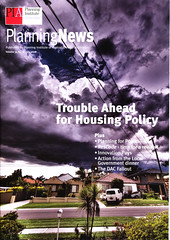 Originally published as an editorial under a joint by line with Tim Westcott and Gida Di Vincenzo in Planning News 34, no. 6 (July 2008): 4.
Originally published as an editorial under a joint by line with Tim Westcott and Gida Di Vincenzo in Planning News 34, no. 6 (July 2008): 4.
It is a busy time in planning. The government’s announcement last month of new “Development Assessment Committees” (DACs) to make planning decisions in Melbourne 2030’s Principal Activity Centres (and other – as yet unspecified – sites of metropolitan significance) is just one aspect of a fast-changing planning environment. It occurs alongside the potentially game-changing review of the residential zones; the introduction of the Urban Growth Zone; the fallout from the Eddington Report; and with the still-mysterious review of the Act looming on the horizon.
In this context, it’s a shame that the kerfuffle over the proposed DACs largely overshadowed one of the most important recent attempts to pause and take stock. The report of the Melbourne 2030 Audit Expert Group (AEG) was released simultaneously with the government’s response to it, and it was overshadowed by the story of the DACs and their implicit threat to the role of local government. This is unfortunate, as the AEG report is a solid, well-considered stock take of where we now stand. It mounts a spirited defence of the core ideas of Melbourne 2030, but is also admirably clear in spelling out how its implementation has fallen short.

